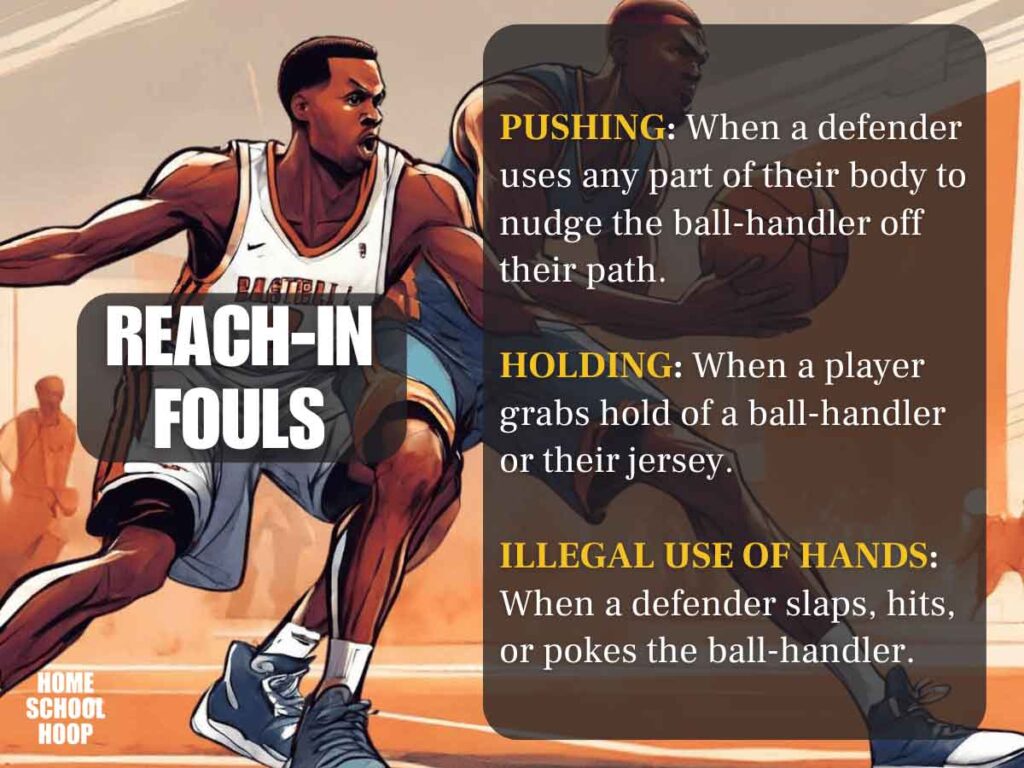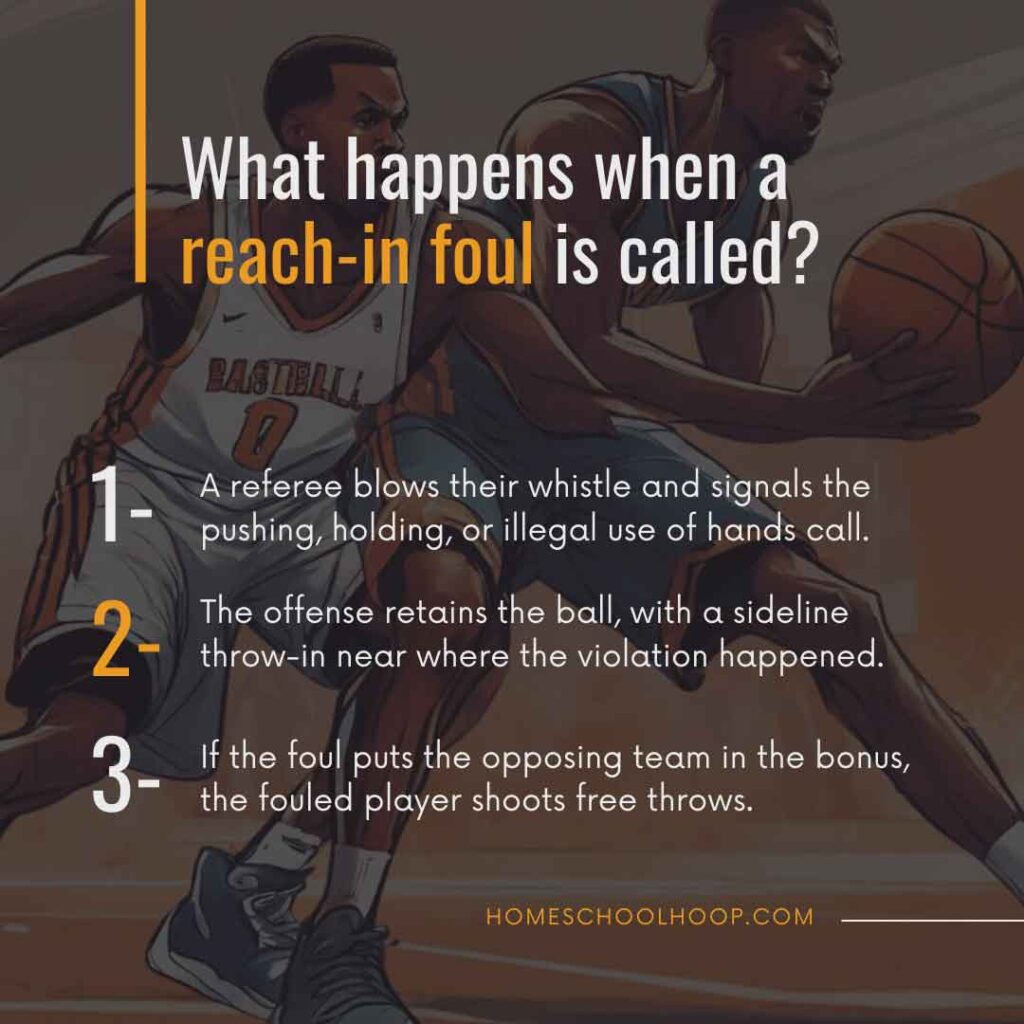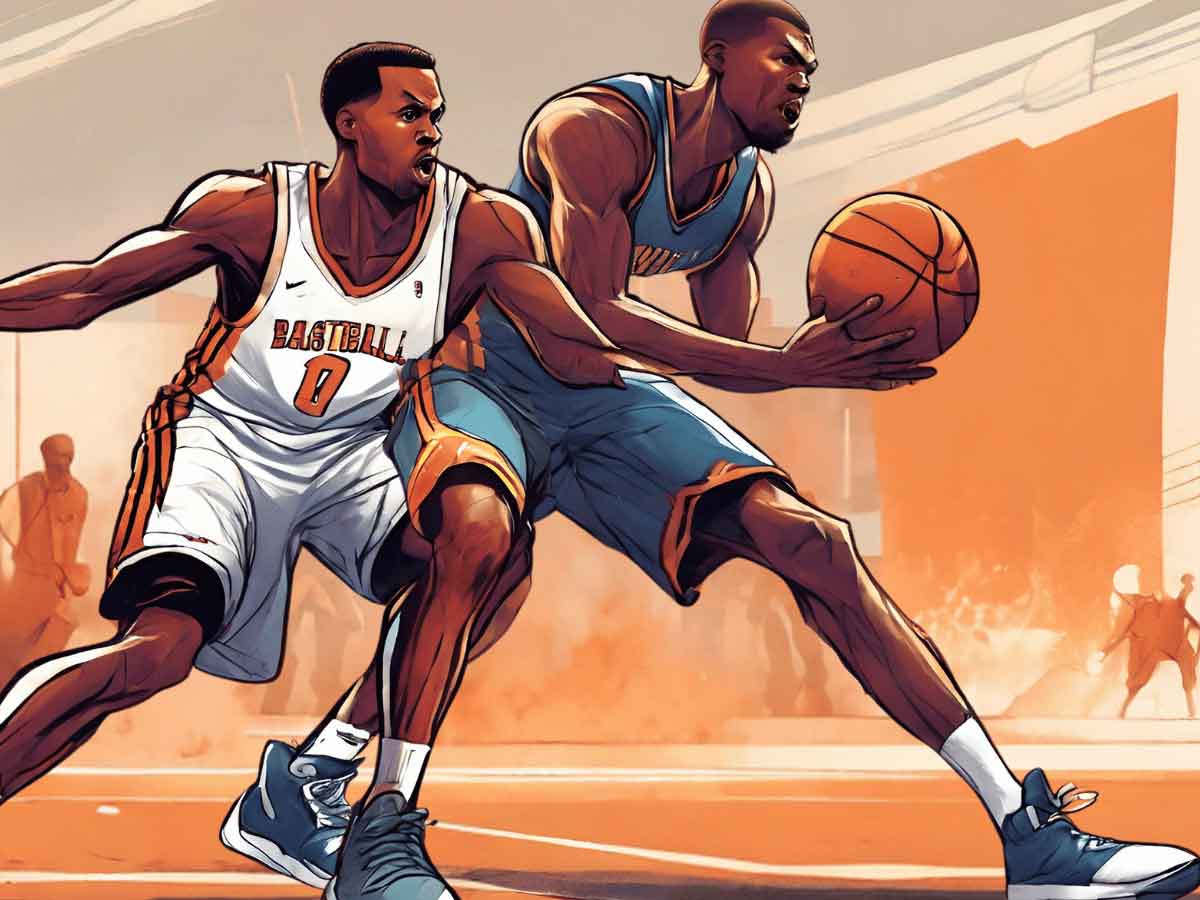I’m sure you’ve heard it – “Don’t reach!” It’s that stern advice yelled out by coaches and fans when an overly ambitious defender attempts to swipe the ball from an opponent. You know it, and I know it – reach-in fouls are arguably the most frustrating because they’re often the result of undisciplined play.
But here’s something you might not know – there is no such thing as a reach-in foul in basketball.
What we often refer to as a “reach-in foul” is a scenario where a defender tries to poke away the ball and, unfortunately, ends up making illegal contact and getting called for a foul. In official rulebooks, such actions are classified as pushing, holding, or illegal use of hands.
Key Takeaways:
- The so-called reach-in foul is when a defender tries to steal the ball from a ball-handler but instead makes illegal contact.
- No official “reach-in foul” exists in basketball; they’re identified as either pushing, holding, or illegal use of hands.
- Such fouls add to the team’s and the individual player’s tally of fouls.
Despite its absence from official rulebooks, the reach-in foul plays a big role in shaping player defense. You want defenders to be aggressive, but smart. So, the foul represents the thin line between a stellar defensive play and an unsmart move that could cost the team.
Here, we hope to demystify reach-in fouls. We’ll cover their importance, how they’re called, and the effect they have on the game. Plus, we’ll offer some tips for players to avoid them.
Definition of a Reach-In Foul
A reach-in foul in basketball is a term that pops up whenever a defender gets a little too eager while trying to snag the ball from an opponent.
It happens when a defender tries to steal the ball from the offensive player by reaching in toward the ball. But instead of snagging the ball cleanly, they end up making illegal contact with the offensive player.
However, here’s a little twist: the term “reach-in foul” isn’t officially recognized in the basketball rulebooks. What we often refer to as a reach-in foul usually falls into one of three categories: pushing, holding, or illegal use of hands.
- Pushing happens when a defender uses their hands or any part of their body to nudge the ball-handler off their path.
- Holding is what it sounds like — grabbing hold of the ball-handler or even their jersey, preventing them from moving freely.
- Illegal use of hands is when a defender slaps, hits, or pokes a player with the ball.

How is a Reach-In Foul Different from Other Fouls?
It can be easy to mix up reach-in fouls with other forms of illegal contact fouls. But reach-in fouls are distinct compared to the likes of hand-checking and blocking.
- Hand-checking involves a defender using their hands to impede or control the movement of the ball-handler. It’s related to a more constant contact, unlike the quick jab that characterizes a reach-in foul.
- A blocking foul is when a defender uses their body to impede the progress of an offensive player without first establishing a legal position. It’s about the defender illegally stopping a ball-handler’s advance with their body.
Navigating the Fine Line: Reach-In vs. Steal
Defenders often reach in because they’re excited to make a big steal. And sometimes, particularly when done by players with quick hands, it works. So, it’s important to understand the fine line between a reach-in foul and a legal steal:
- A reach-in becomes a foul only when the defender makes illegal contact with the offensive player.
- “Reaching in” itself is not illegal. A defender can legally attempt to steal the ball as long as they do not make contact with the offensive player.
- A successful poke at the ball that results in the defender gaining possession without illegal contact is considered a legal steal.
The Rules Surrounding Reach-In Fouls
There’s a fine line between a smooth steal and a foul. All basketball leagues agree: illegal contact during a steal attempt isn’t allowed. However, the way this is interpreted can vary from one league to another. Let’s break down how different basketball leagues view what many call a “reach-in foul.”
NBA’s Take on Reach-In Fouls
In the NBA, the term “reach-in foul” isn’t explicitly mentioned in the rulebook. What the rules do cover is illegal contact made by a defender on a player who’s holding the ball.
The NBA rulebook states, “Contact initiated by the defensive player guarding a player with the ball is not legal. This contact includes, but is not limited to, forearm, hands, or body check.”
Here’s the gist:
- Touching the player with the ball in any manner is off-limits.
- Accidental contact? Even so, if you reach in and make contact with your hand or forearm, it’s a foul.
WNBA’s Rules on Defensive Contact
The WNBA shares a similar stance on defenders touching ball-handlers.
The WNBA rules outline, “A player shall not hold, push, charge into, impede the progress of an opponent by extending an arm, leg or knee or by bending the body into a position that is not normal.” It then goes on to add that, “Contact initiated by a defensive player guarding a player with the ball is not legal.”
This means:
- Keeping your arms, legs, and body to yourself is crucial. There’s no pushing or holding of any players, let alone the player with the ball.
- Any form of contact while defending the ball-handler is particularly scrutinized as pushing or holding.
NCAA Men’s Basketball on Reach-In Fouls
NCAA Men’s Basketball has its way of addressing what might resemble a reach-in foul, stating, “A player shall not contact an opponent with their hand(s) unless such contact is incidental or is only with the opponent’s hand while it is on the ball and is incidental to an attempt to play the ball.”
In plain language:
- If your hand is going for the ball and accidentally touches the other player’s hand while it’s on the ball, that’s usually okay.
- It’s a foul if you touch anywhere else on the ball-handler as you reach in.
NCAA Women’s Basketball and Reach-In Foul Rules
NCAA Women’s Basketball emphasizes, “A player shall not contact an opponent with their hand(s) unless such contact is incidental or is only with the opponent’s hand while it is on the ball and is incidental to an attempt to play the ball.”
Simply put:
- Accidental contact with the hand of a ball-handler is fine if you’re genuinely trying to get the ball.
- Otherwise, making contact with a ball-handler with your hand is prohibited.
The Impact of Reach-In Fouls on the Game
Though you won’t find the term “reach-in foul” in rulebooks, these fouls have an undeniable effect on games. They’re not just a concern for the player caught reaching; their impacts ripple through the whole team, influencing the game’s pace, strategy, and the all-important foul count.
What is the Penalty for a Reach In Foul?
No matter which league you’re watching or playing in, the consequences of a reach-in foul are standard: it results in a personal foul for the player and adds to the team’s total foul count.
This has a direct impact on players and teams:
- For Players: Accumulating too many personal fouls can lead to a player being benched to avoid foul trouble or, worse, fouling out of the game.
- For Teams: As the team’s foul count climbs, they edge closer to a basketball bonus situation. This gives the opposing team free throws for non-shooting fouls, which can be a game-changer.

Curious about foul limits? Find out how many fouls to foul out in the WNBA.
Why Reach-In Fouls Are Important
Seemingly trivial on their own, reach-in fouls significantly impact the outcome of a game. Here are some ways how:
- Game Pace: Frequent fouls slow down the action, affecting teams that thrive on fast-paced play. It also gives the opposing team a chance to catch their breath and regroup.
- Strategic Shifts: Coaches find themselves having to tweak their original game plan and are limited on the personnel changes they can make based on players in foul trouble. This might mean having to put a less experienced player on the floor or changing defensive tactics to manage matchups.
- Foul Trouble Fallout: A player with too many fouls doesn’t only damper the defensive aggressiveness of that player but also dims the overall team morale.
- Free Throw Factor: In close games, a team getting into bonus means free throws on non-shooting fouls. These free shots can easily tip the scales.
Reach-In Foul Examples
Understanding reach-in fouls is easier when you can see them in action. Video can offer a clear view of what constitutes a reach-in foul and how it impacts the game. Let’s look at a few instances from games where players were called for illegal contact.
Cameron Payne’s Lesson in Overreaching
- Scenario: While playing for the Oklahoma City Thunder, Cameron Payne reaches in while trying to defend the Denver Nuggets’ ball handler. Instead of a clean steal, Payne gets called for a blocking foul.
- Learning Point: This example shows the risk of reaching in. Instead of poking the ball away, Payne makes enough contact to be called for a blocking foul, how quickly ambition can turn into a penalty.
Michigan’s Near-Steal Turned Foul
- Scenario: With only 17 seconds left and down by one point against UCLA, a Michigan player attempts a reach-in steal but ends up making contact with the offensive player’s elbow, resulting in a foul.
- Learning Point: This scenario underlines the importance of timing and precision in defense, especially in crucial game moments. What was intended as a game-saving play instead allowed the opponent to extend their lead from the free-throw line.
DeWanna Bonner’s Reach-In
- Scenario: DeWanna Bonner of the Connecticut Sun reaches around and makes contact with Courtney Vandersloot of the Chicago Sky. Bonner is called for the foul, although she disagrees with the decision.
- Learning Point: This incident highlights defensive discipline’s significance. Bonner’s decision to reach around, despite the slim chances of a clean steal, resulted in a foul call. Even slight contact when reaching for the ball can be enough for a referee to call a foul.
How Players Can Avoid Committing Reach-In Fouls
Playing great defense in basketball takes a fine balance between aggression and control. Yes, it’s about hustle, but it also takes playing smart and staying out of foul trouble. Let’s talk about how you can disrupt the offense without giving the refs a reason to blow the whistle on you for reach-in fouls.
Let’s Talk Footwork
First up, solid footwork. You’re less likely to use your hands illegally if you’re able to move quickly and stay in front of the ball-handler.
- Practice Your Lateral Agility: Practice lateral movements and defensive slides to keep up with offensive players.
- Stay Ready: Stay balanced and on the balls of your feet. This way, you can move quickly in any direction.
Positioning Takes Priority
Being in the right place at the right time is huge. It means you won’t have to make a desperate reach-in attempt.
- Keep a Safe Distance: Stay close enough to challenge shots or passes but far enough that you’re not tempted to reach in. An arm’s length is about right.
- Block the Path to the Basket: Make it hard for your opponent to get an easy shot by positioning yourself between them and the hoop.
Guessing the Next Move
If you can guess where the offensive player is heading, you won’t need to foul them to stop them.
- Eyes on the Core: Watch the player’s midsection. Unlike feet or the head, it doesn’t fake out easily.
- Know the Plays: Familiarize yourself with a team’s common plays and player habits so you can anticipate what’s coming.
Keep Your Head Cool
Perhaps the most crucial aspect of avoiding reach-in fouls: discipline. Sometimes, the best move is not to make a move.
- Not Every Ball Is Yours: It’s okay to let some opportunities pass if going for them might result in a foul.
- Weigh the Risks: Think about whether trying for a steal is worth the risk of fouling, especially if you’re already in foul trouble.
The Controversy Surrounding Reach-In Foul Calls
Talk about a topic that gets everyone heated – reach-in foul calls are right up there, stirring up plenty of passion. Why? They’re often subjective. Two refs can watch the same play but walk away with completely different takes. It’s no wonder players, coaches, and fans can get all riled up.
Here’s the deal with reach-in foul calls: they’re tricky and hard to judge. Unlike a shot clock violation, which is clear-cut, determining whether a defensive player made illegal contact when they reached toward the ball can vary by perspective.
Basketball moves fast, and so do reach-in attempts. Referees have their work cut out for them, trying to catch every detail in real time. Plus, where they’re standing can change their view of the play. What looks like a clean steal from one side of the court might appear like a clear foul from another.
At the pro level, refs might let a lot slide. But more often than not, reaching in gets you a whistle. That’s even more reason why players need to focus on playing solid defense and staying out of those iffy situations where you could be called for a reach-in foul.
FAQs
What is considered a reach-in foul?
A reach-in foul happens when a defender tries to steal the ball and makes illegal contact with the player holding it.
How do you not reach in basketball?
To avoid reaching in basketball, focus on staying in front of the offensive player, maintaining a good defensive stance and position, using your feet and body to defend instead of your hands, and anticipating the offensive player’s moves to avoid the need for last-second reaches.
Can a reach-in foul lead to free throws?
Yes, a reach-in foul can lead to free throws. If the team committing the foul is over the limit for fouls in a period, the fouled player gets to shoot free throws, even if the foul wasn’t during a shooting attempt.
How does a reach-in foul affect player foul trouble?
A reach-in foul counts as a personal foul for the player who commits it. If a player accumulates too many personal fouls, they can get into foul trouble, risking being benched to avoid disqualification from the game or, ultimately, fouling out and being forced to leave the game.
WHAT’S YOUR TAKE?
Today, you learned about the reach-in foul in basketball.
So we want to know: If you’re a player or coach, what drills or techniques do you use to train yourself or your team to avoid committing reach-in fouls?
Share your strategies and tips in the comments.

